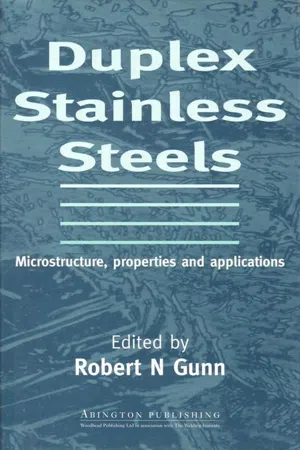
This is a test
- 216 pages
- English
- ePUB (mobile friendly)
- Available on iOS & Android
eBook - ePub
Book details
Book preview
Table of contents
Citations
About This Book
Two very successful conferences - in Glasgow and Beaune - were held on duplex stainless steels during the first half of the '90s. This book takes keynote papers from each, and develops and expands them to bring the topics right up to date. There is new material to cover grades, specifications and standards, and the book is fully cross-references and indexed.The first reference book to be published on the increasingly popular duplex stainless steels, it will be widely welcomed by metallurgists, design and materials engineers, oil and gas engineers and anyone involved in materials development and properties.
- The first reference book on this relatively new engineering material
- Based on keynote papers from major international contributors
- Covers grades, standards and specifications
Frequently asked questions
At the moment all of our mobile-responsive ePub books are available to download via the app. Most of our PDFs are also available to download and we're working on making the final remaining ones downloadable now. Learn more here.
Both plans give you full access to the library and all of Perlego’s features. The only differences are the price and subscription period: With the annual plan you’ll save around 30% compared to 12 months on the monthly plan.
We are an online textbook subscription service, where you can get access to an entire online library for less than the price of a single book per month. With over 1 million books across 1000+ topics, we’ve got you covered! Learn more here.
Look out for the read-aloud symbol on your next book to see if you can listen to it. The read-aloud tool reads text aloud for you, highlighting the text as it is being read. You can pause it, speed it up and slow it down. Learn more here.
Yes, you can access Duplex Stainless Steels by R Gunn in PDF and/or ePUB format, as well as other popular books in Technology & Engineering & Mining Engineering. We have over one million books available in our catalogue for you to explore.
Information
1
Developments, grades and specifications
1.1 Historical developments
Stainless steels were developed during the first decades of the twentieth century in the United Kingdom and Germany. The earliest grades were martensitic and ferritic Fe-Cr steels, but quite soon the austenitic Fe-Cr-Ni steels became the largest group. The growth of the austenitic alloys stemmed from their ease of production and fabrication, particularly welding. Minimum carbon levels were high (around 0.08%), due to the existing furnaces and refining techniques. This made the steels sensitive to grain boundary carbide precipitation during heat treatment and welding, and sensitive to intergranular corrosion attack.
A duplex alloy is defined as one that contains a two-phase structure and is more often a descriptor of an alloy where both phases are present in significant quantities. In the context of this book, the term duplex stainless steel covers ferritic/austenitic Fe-Cr-Ni alloys with between 30% and 70% ferrite. The first reference to such alloys appears in 1927, when Bain and Griffith1 published data on ferritic:austenitic structures. Within the next few years, several foundries in France, Germany, Sweden and the USA explored such steels, initially in the cast form.
Possibly the first commercial product dates from 19292 when Avesta Jernverk produced a grade called 453E with approximate composition 25%Cr-5%Ni. Soon after in 1932 and 1933 a modified grade with 25%Cr-5%Ni-1%Mo (grade 453S) was marketed. Applications included coolers of the Brobeck type (plate and forgings), autoclaves ...
Table of contents
- Cover image
- Title page
- Table of Contents
- Dedication
- Copyright page
- Preface
- Abbreviations and glossary
- 1: Developments, grades and specifications
- 2: Alloy design
- 3: Microstructure
- 4: Forming and machining
- 5: Physical and mechanical properties
- 6: Corrosion
- 7: Stress corrosion cracking
- 8: Welding metallurgy
- 9: Welding processes
- 10: Weldment properties
- 11: Non-destructive testing of welds
- 12: Applications
- 13: Service experience
- Appendix A: Nominal composition of stainless steels and Ni-base alloys
- Appendix B: Welding consumables for duplex and superduplex stainless steel grades
- Index